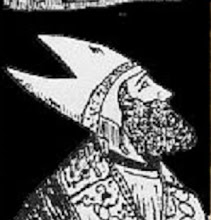By Wyatt Ciesielka
Tuesday, June 01, 2010
You will soon become familiar with Tirhakah. He was a mighty Egyptian pharaoh – a historic King of the South embroiled in incessant war with a historic King of the North. Tirhakah will again become famous largely because Will Smith (of “Men in Black”, “Ali” and “Hitch” fame) intends to star in a movie “of epic proportions” about him. But students of prophecy should be interested in Tirhakah for other reasons.
Tirhakah was the celebrated last Pharaoh of the 25th Egyptian dynasty – the Ethiopian dynasty, ruling circa 689 to 664 B.C. Because his glory was unsurpassed by subsequent pharaohs, Tirhakah is inaccurately called “The Last Pharaoh.” However, Tantamani, and the famous Cleopatra were pharaohs after him. And, scripture predicts a final pharaoh immediately before Christ’s return.
The Bible in 2 Kings 19:9 and Isaiah 37:9 record that it was Tirhakah who unsuccessfully attempted to repel the Assyrian hosts threatening King Hezekiah. But, his story should be of interest to students of the Bible, because the Egypt of Tirhakah’s past holds clues to Egypt’s and the Middle East’s future.
Around 740 B.C. Tirhakah’s father, Piye, invaded Egypt. At the time of Piye’s invasion, Egypt had fragmented into eleven feuding states governed by rulers of Libyan descent. This was the time of the Twenty-Second Egyptian Dynasty (circa 945-730 B.C.). Piye conquered and unified Egypt. His son, Tirhakah, ascended to a unified and powerful throne – rivaled only by the mighty Assyrian empire.
Initially, Tirhakah repelled numerous invasions by Assyria’s King Esarhaddon. However, by 671 B.C. the Assyrians overwhelmed Tirhakah’s forces, and Egypt was pillaged. Eventually, the Assyrians drove Tirhakah out of Lower Egypt, and his kingdom collapsed in 667 B.C.
After Assyrian King Esarhaddon’s death, Tirhakah returned to Egypt and routed the Assyrians. However, his victory was short-lived. Esarhaddon’s son, Assurbanipal, promptly set out from Nineveh and devastated Tirhakah’s armies. Tirhakah would flee all the way to his homeland of Nubia, where he remained until he died. He was buried under a 150-foot-high pyramid in Nuri, located in modern-day Sudan.
What is the significance for modern times?
While Tirhakah is inaccurately called “The Last Pharaoh,” scripture foretells a future pharaoh over Egypt (Isaiah 30:2-3). Scripture also foretells a future king who will rule over the consolidated peoples of Egypt, Ethiopia, Sudan and much of the rest of the Middle East.
Tomorrow’s World has often referenced the prophetic passage of Isaiah 30:13, which indicates that modern Jacob’s fall will come suddenly, like “a bulge in a high wall, whose breaking comes suddenly, in an instant.” This same prophetic passage shows Egypt as a leading power during this time (vv. 2, 3, 7). When combined with passages such as Psalms 83 and Daniel 11, the indication is that Egypt will be part of, if not the leader of, this powerful end-time Islamic confederation located geographically south of Jerusalem.
As Tirhakah’s story illustrates, Egypt and Ethiopia have occasionally been under the same government. When one considers the story of Tirhakah’s rule over consolidated peoples, and understands that the ethnicities mentioned in Daniel 11 and Psalms 83 include the Egyptians, Ethiopians (modern Cushites predominantly south of Egypt), Libyans, Edomites, etc., the Bible’s warnings that this entire region will again rally around a strong leader just as it did under Tirhakah nearly 2500 years ago become easily understandable.
The Church of God has proclaimed for decades that the final King of the South will lead a confederation of Muslim nations located in the Middle East and North Africa into war against the final King of the North. This future King of the South will again) be overwhelmed by this future King of the North.
Watch events in the Middle East! And, please read the Tomorrow’s World articles, “The Final Crusade?” and “"Conflict Over the ‘City of Peace"” and the detailed booklet, "The Middle East in Prophecy" to better understand how the Middle East will shake the nations just prior to Christ’s return."
• If you appreciate these insights – "click here to receive them by email."
The Seven Churches of Revelation 1, 2, 3
-
COGwriter at site of “Church of the Apocalypse/Revelation” on Patmos in
2008 COGwriter Seven churches are mentioned in Revelation 1, with messages
given ...
4 hours ago




No comments:
Post a Comment